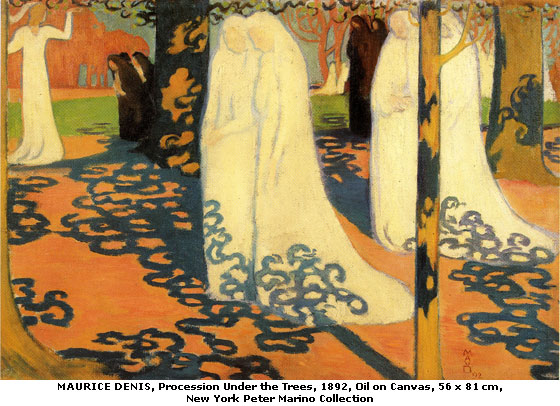Robert Gildea, Children of the Revolution
Symbolism and the Other Arts
Symbolism, or the search for a more spiritual art, shaped not only the poetry and literature of the fin de sieclebut also painting,
|
drama and music. As a reaction against the contemporary world, it could end up either in retreat from the world or in criticism of it. The death of Manet in 1883 dealt a blow to Impressionism, which embraced modern life and fixed the impressions it made, and artists took new directions. In 1886 Gauguin discovered Brittany, with its heaths and rocky coves, little chapels and traditional costumes. 'There I find the savage and primitive,' he wrote, and by 1888 he had gathered a group of artists of the I86o generation at the fishing village of Pont-Aven. These included Emile Bernard, who perfected the cloisonne method of painting, with blocks of colour divided by black lines, as in stained glass, and Paul Serusier, whose rendering of a landscape on the lid of Gauguin's cigar box became the talisman of the group. '3 Linked to them was Maurice Denis, who took an oath on All Saints' Day 8 84 to remain always a Christian and announced in I886 that 'even the purest realism and naturalism cannot satisfy . .. we must make an effort, a great effort, to bring Art back to its great master, who is God.''4 After Gauguin sailed to Tahiti in 1891 in search of more primitive societies, this group became the core of the Nabis, including Pierre Bonnard and Edouard Vuillard. For them Denis wrote a ma nifesto stating that 'before it becomes a war-horse, a nude woman or some anecdote, a painting is essentially a flat surface covered with colours assembled in a certain order.''s The Nabis were keen to ap ply their techniques to other decorative arts, such as tapestries and stage sets, and Denis had been at the Lycee Condorcet with avant-garde theatre director Aurelien Lugné-Poë. Lugné-Poë and the Nabis shared a studio in the rue Pigalle and after 1893 the Nabis d esigned sets and programmes for the north European idealist d ra ma at the Theatre de !'Oeuvre, notably Pelléas et Mélisande by the Belgian Symbolist Maeterlinck and a string of Ibsen plays from Rosmersholm and An Enemy of the People to The Master Builder in 1893, with not a single French play until 1894.'6
Maurice Denis. The Muses/Les Muses. 1893
